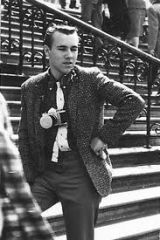- Forum
- Photography and Camera Forum
- Taking the Photo | Editing | The art of Photography!
- Beginner Photography Forum
- How is mirror lens different from normal lenses?
How is mirror lens different from normal lenses?
-
 Topic Author
Topic Author
- Gene.Culley
- Photography Hooked
-
- Nikon D-90
- Followers: 215
- Posts: 804
-
Points:
3399
Post #18258
Thanks!
-

- Scotty
- Agent 007
- James Bond, PT mod.
- Followers: 1088
- Posts: 9885
-
Points:
15051
Post #18263
When the last candle has been blown out
and the last glass of champagne has been drunk
All that you are left with are the memories and the images-David Cooke.
-

- Baydream
- Moderator
-
- Canoni/60D/70D/5DmkIII
- Followers: 388
- Posts: 11185
-
Points:
7280
Post #18264
photocamel.com/forum/photography-talk/44...hat-mirror-lens.html
Shoot, learn and share. It will make you a better photographer.
fineartamerica.com/profiles/john-g-schickler.html?tab=artwork
-
 Topic Author
Topic Author
- Gene.Culley
- Photography Hooked
-
- Nikon D-90
- Followers: 215
- Posts: 804
-
Points:
3399
Post #18300
"Catadioptric lenses are also used for photography, where they are known as 'reflex' or 'mirror' lenses. They are much lighter, smaller, and cheaper than refractive lenses with comparably long focal lengths (> 300 mm), but at the cost of some optical compromises.
Refractive-design lenses with focal lengths above 300 mm may use as many as twenty optical elements in a housing of a length comparable to the focal length. Catadioptric designs fold the optical path, greatly reducing the size and weight of the lens, and making longer focal lengths such as 500 mm and 1000 mm more easily accessible. Moreover, chromatic aberration, a major problem with long refractive lenses, is almost completely eliminated.
An example of the Iris Blur produced by a catadioptric lens, behind an in-focus light.
Catadioptric lenses do, however, have several drawbacks. The fact that they have a central obstruction means they cannot use an adjustable diaphragm to control light transmission[11]. This means the lens's aperture value is fixed to the overall focal ratio of the optical system (typically f/8 for 500 mm designs, or f/11). Their modulation transfer function shows low contrast at low spatial frequencies. The folded optical path does reduce the length of the lens, but increases its width.
Finally, their most salient characteristic is the annular shape of defocused areas of the image, giving a doughnut-shaped 'iris blur' or bokeh, caused by the shape of the entrance pupil.
Several companies made catadioptric lenses throughout the later part of the 20th century. Nikon (under the Mirror-Nikkor and later Reflex-Nikkor names) and Canon both offered several designs, such as 500 mm 1:8 and 1000 mm 1:11. Smaller companies such as Tamron also offered their own versions. Of the major manufacturers, currently only Sony (formerly Minolta) offers a 500 mm catadioptric lens for their Alpha range of cameras. The Sony lens has the distinction of being the only reflex lens manufactured by a major brand to feature auto-focus (aside from the identical Minolta-manufactured lens that preceded Sony's production)."
-

- Scotty
- Agent 007
- James Bond, PT mod.
- Followers: 1088
- Posts: 9885
-
Points:
15051
Post #18341
Gene.Culley wrote: Ok I found a really good explanation of what it is here: en.wikipedia.org/wiki/Mirror_lens Pretty interesting, but I think i will take your advice and keep looking. Thanks everyone!
"Catadioptric lenses are also used for photography, where they are known as 'reflex' or 'mirror' lenses. They are much lighter, smaller, and cheaper than refractive lenses with comparably long focal lengths (> 300 mm), but at the cost of some optical compromises.
Refractive-design lenses with focal lengths above 300 mm may use as many as twenty optical elements in a housing of a length comparable to the focal length. Catadioptric designs fold the optical path, greatly reducing the size and weight of the lens, and making longer focal lengths such as 500 mm and 1000 mm more easily accessible. Moreover, chromatic aberration, a major problem with long refractive lenses, is almost completely eliminated.
An example of the Iris Blur produced by a catadioptric lens, behind an in-focus light.
Catadioptric lenses do, however, have several drawbacks. The fact that they have a central obstruction means they cannot use an adjustable diaphragm to control light transmission[11]. This means the lens's aperture value is fixed to the overall focal ratio of the optical system (typically f/8 for 500 mm designs, or f/11). Their modulation transfer function shows low contrast at low spatial frequencies. The folded optical path does reduce the length of the lens, but increases its width.
Finally, their most salient characteristic is the annular shape of defocused areas of the image, giving a doughnut-shaped 'iris blur' or bokeh, caused by the shape of the entrance pupil.
Several companies made catadioptric lenses throughout the later part of the 20th century. Nikon (under the Mirror-Nikkor and later Reflex-Nikkor names) and Canon both offered several designs, such as 500 mm 1:8 and 1000 mm 1:11. Smaller companies such as Tamron also offered their own versions. Of the major manufacturers, currently only Sony (formerly Minolta) offers a 500 mm catadioptric lens for their Alpha range of cameras. The Sony lens has the distinction of being the only reflex lens manufactured by a major brand to feature auto-focus (aside from the identical Minolta-manufactured lens that preceded Sony's production)."
They're pretty horrible.
When the last candle has been blown out
and the last glass of champagne has been drunk
All that you are left with are the memories and the images-David Cooke.
-

- Stealthy Ninja
- Moderator
-
- Fuji X stuff and a 1DsIII for some reason
- Followers: 982
- Posts: 16300
-
Points:
6837
- Forum
- Photography and Camera Forum
- Taking the Photo | Editing | The art of Photography!
- Beginner Photography Forum
- How is mirror lens different from normal lenses?
Latest Reviews
The Olympus Pen E-P7 is an affordable micro four thirds mirrorless camera with 4K video capabilities, a 20.3MP sensor, and 121 focus points, making it a solid entry-level camera for beginners.
The Panasonic G9 II is a 25.2-megapixel micro four thirds camera with numerous features that make it punch out of its weight class, like 779 AF points, 5.8K video, and weather sealing.
The Fujifilm XT5 is a 40MP mirrorless camera capable of 6.2K video at 30p. With those specs, it’s an ideal choice for photographers needing a camera to pull double duty for imaging and video.
The Canon EOS R100 is an entry-level mirrorless camera introduced in 2023. But just because it’s an entry-level camera doesn’t mean it’s a bare-bones camera. Find out why in this review!
Latest Articles
The best photography jobs right now are a mix of tried-and-true gigs like wedding photography and new jobs highlighting AI’s capabilities, travel, and videography.
The Olympus Pen E-P7 is an affordable micro four thirds mirrorless camera with 4K video capabilities, a 20.3MP sensor, and 121 focus points, making it a solid entry-level camera for beginners.
Starting a photography business is one thing; sustaining your business over a long period of time is another. Use the tips in this professional photography guide to build something with longevity!
The Panasonic G9 II is a 25.2-megapixel micro four thirds camera with numerous features that make it punch out of its weight class, like 779 AF points, 5.8K video, and weather sealing.
Cinematic photography is an interesting genre that combines photographic and videographic skills along with effective storytelling techniques. The result? Highly impactful images!
Newborn photography requires skill, the right gear, and a lot of patience. This beginner’s guide discusses critical topics that will help you be more prepared for before, during, and after the shoot.
To fill the frame means to expand the footprint of the subject in your shot. Get in close, zoom in, crop the image, or use other techniques to bring the subject to the forefront.
With these simple yet effective beginner photography tips, you can avoid some of the common mistakes beginners make and get improved results with your images.
















